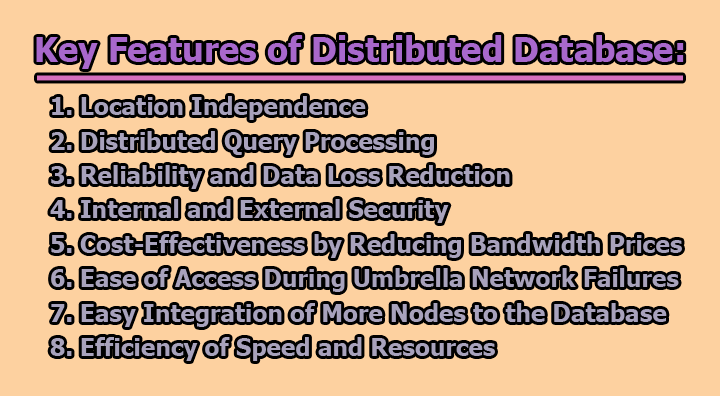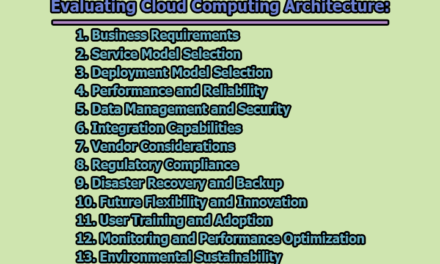Key Features of Distributed Database:
A distributed database is a collection of interconnected databases that are spread across different geographical locations and communicate with each other through a network. Unlike a centralized database, where all data is stored in a single location, a distributed database allows for the distribution of data across multiple nodes or servers. In this discussion, we will explore the key features of distributed databases.
1. Location Independence: Distributed databases provide location independence, allowing users and applications to interact with the data without being concerned about its physical location. This is achieved through a layer of abstraction provided by the database management system (DBMS). Users can query and update the database without needing to know where the data is stored. This feature enhances flexibility in data access, as users can retrieve information seamlessly, regardless of the geographical distribution of the database nodes.
2. Distributed Query Processing: One of the key features of distributed databases is their ability to process queries across different nodes concurrently. Distributed query processing enhances the overall efficiency and performance of the system. When a query is executed, it can be divided into subqueries that run in parallel on multiple nodes. This parallel processing capability significantly reduces the time required to retrieve and process data. It also contributes to better utilization of resources across the distributed environment, optimizing the overall system performance.
3. Reliability and Data Loss Reduction: By distributing data across multiple nodes, distributed databases enhance reliability and minimize the risk of data loss. Each piece of data is replicated or distributed across several nodes, ensuring that if one node fails, the data remains accessible from other locations. This redundancy and fault tolerance contribute to high availability. In case of hardware failures, network issues, or other unforeseen events, the distributed database can continue to operate without a significant loss of data or disruption to services.
4. Internal and External Security: Security is a paramount concern in distributed databases, both internally and externally. Internal security mechanisms involve controlling access privileges and permissions within the database system. Encryption is commonly used to secure data during transmission between nodes, preventing unauthorized access. External security measures include authentication protocols to verify the identity of users and nodes connecting to the distributed database. Access control policies ensure that only authorized entities can interact with specific data, protecting the database from unauthorized access or malicious activities. The combination of internal and external security features makes distributed databases robust and secure in handling sensitive information.
5. Cost-Effectiveness by Reducing Bandwidth Prices: The distributed nature of databases often leads to cost-effectiveness, particularly in terms of bandwidth usage. Distributing data across nodes can help in reducing the amount of data transferred over the network, which, in turn, lowers bandwidth costs. This optimization is achieved through techniques such as data compression, efficient data transfer protocols, and intelligent routing. By minimizing the amount of data transmitted between nodes, organizations can achieve cost savings in terms of network infrastructure and associated expenses.
6. Ease of Access During Umbrella Network Failures: Distributed databases are designed to maintain access to data even in the presence of failures in the umbrella network that connects different sites. This feature ensures that users can continue to access and interact with the database, even if there are disruptions or failures in the overarching network infrastructure. It is achieved through techniques such as data replication, load balancing, and network partitioning strategies. Maintaining accessibility during network failures contributes to the overall reliability and continuity of operations in distributed database systems.
7. Easy Integration of More Nodes to the Database: Scalability is a key feature of distributed databases, and one aspect of scalability is the ability to easily integrate additional nodes into the existing database system. This allows organizations to adapt to changing requirements by expanding the infrastructure as needed. Whether due to increased data volumes, growing user base, or other factors, the ease of integrating more nodes ensures that the distributed database system can scale horizontally. This scalability contributes to the flexibility and long-term viability of the database architecture.
8. Efficiency of Speed and Resources: Distributed databases are engineered for efficient utilization of speed and resources. Parallel processing of queries, load balancing, and optimization techniques contribute to the overall efficiency of the system. By distributing the workload across multiple nodes, the database system can handle a larger number of concurrent operations, leading to improved response times. Efficient use of resources, both in terms of computing power and storage, is a critical aspect of distributed databases, allowing organizations to achieve high performance and responsiveness in their data management systems.
In conclusion, while distributed databases offer several features in terms of scalability, reliability, and efficiency, addressing concerns such as consistency and complexity of implementation is essential to fully leverage their potential in a networked environment. The features mentioned contribute to the collaborative and interconnected nature of distributed databases, making them a powerful solution for modern data management needs.

Library Lecturer at Nurul Amin Degree College










